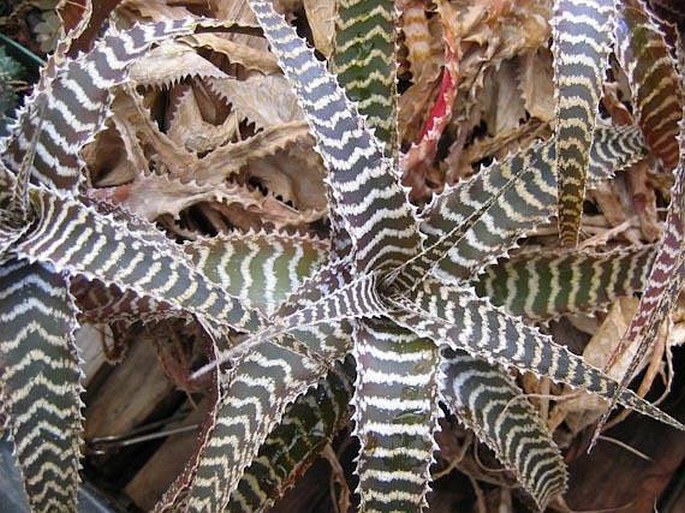Family: Bromeliaceae Juss.

Distribution: Genus Orthophytum contains about 55 species, all are endemic to eastern part of Brazil, they grow in phytogeographic areas of Caatinga, Cerrado and Mata Atlântica. This species is narrowly endemic in Brazilian state of Minas Gerais (Teófilo Otoni).
Ecology: Rocky outcrops associated with Lycopodium, Vellozia, etc.
Description: Succulent plant with short, thick caudex; non-blooming plants up to 15 cm tall, 25 cm in diameter, larger in shade; leaves suberect to spreading. Flowering plant 40 cm tall with leaves to 25 cm long, 4.5 cm wide at base, shallowly and broadly canaliculate, spreading, arching recurved or the uppermost on the inflorescence deflexed, with distinct sheath enfolding the stem, the blades broadly triangular, laxly spinose with teeth up to 2.5 mm long, deep purplish to purplish brown, irregularly and sparsely white lepidote beneath, above white lepidote in straight, wavy or irregular to jagged lines mostly 2–3 mm wide, extending to the margins or nearly zebra-striped, alternating with glabrous zones about 5 mm wide. Scape arching, stout about 15 mm in diameter basaly, 6 mm under the first flowers, densely white lepidote with purplish epidermis visible. Scape bracts forming from largest leaves upward to short triangular. Inflorescence laxly bipinnate, primary bracts like scape bracts but much reduced; 3–6 spikes sessile, semiglobose, up to 3 cm tall and 4 cm wide, pale green; floral bracts lanceolate, acuminate, exceeding flowers; flowers 15–16 mm long, sessile, sepals symmetric, whitish to pale green, 13 mm long; petals 15–16 mm long, linear, obtuse apically, white; filaments white, ovary ovate, 4 mm; style barely exserted, whitish.
Threat and protection: The author, Paul Hutchinson called the plant “narrow endemic”, stating that it is found in an area 100 × 100 m, which would be critical for the species. Lack of literature on this species, outside of cultivation notes, doesn’t state if further habitats have ever been found.
Notes: Like many other bromeliads, this plant is monocarpic and dies after flowering, however, in culture the plant offsets freely and some inflorescences grow adventitious plants which can be rooted.





These images were taken in culture.


